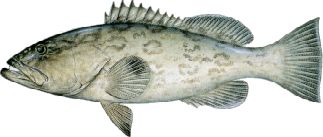Regulations: 22″ minimum size limit for all species except Warsaw which has no minimum size; total of 4 fish (aggregate number of all species) per person per day limit; Warsaw grouper limit is 1 per vessel per day and does not count in aggregate limit
General Information: This group of species share an interesting life history trait. All groupers begin life as males and over time transform into females. The spawning season is in the winter and spring except for the jewfish which spawns in the summer. Grouper are usually caught offshore but the younger individuals live in sea grass beds or around mangroves. Occasionally anglers catch legal sized fish in the deeper holes of the backwaters. Groupers live close to the bottom and always associate with some type of submerged structure.
Distribution: There are a number of grouper species caught in Florida. The gag and red groupers and the jewfish (a species permanently closed to all harvest) are the most widely distributed species. Most of the other species – Nassau, Red Hind, Rock Hind, Black, Yellowfin and Scamp live in and around the coral reefs of extreme south Florida.
Tackle and Techniques: Grouper fishing is primarily an offshore fishery. Drifting a bait a foot or so off the bottom is the typical technique used by recreational anglers. Slow trolling a bait or lure over hard bottom also produces fish. Standard boat tackle with 20 to 40 pound test line and a 40-80 pond test leader is employed so that anglers have a chance to turn the fish’s head away from an underwater ledge or piece of manmade structure and bring it to the surface.
Bait: Grouper will eat anything just about anything that comes their way. A live pinfish, piece of squid, or chunk of fresh cut bait are proven baits when drifting or at anchor. When trolling anglers use deep diving saltwater plugs or jigs Jigs can also work when worked vertically while drifting or at anchor.
Fishing Tips: Groupers do not move fast and prefer to wait for the meal to come close to where they are. When you feel a fish bite, set the hook as soon as you think the fish has the hook and reel in as much line as you can as quickly as possible. Monofilament line stretches up to 28% and that give the fish enough line to duck back into its place of refuge. What you want to do is prevent this by turning the fish’s head up towards the surface. There is a trend among veteran grouper anglers to use one of the new braided or fused lines when fishing for grouper. With nearly no stretch, you have a better chance of turning the fish’s head before it can get under a rock, a condition in which the fish almost always wins and the angler looses.


